Text
Water Music
There is so much movement in stillness, so much speed in slowness.
Today I took a local hike following a stream up Pfannenstiel. As usual, the water won my heart and a new piece came into my head. Now I need to notate it.
It involves B minor and it’s full of love.

0 notes
Text
The Work Wellness Workshop is coming!
Join me in Basel next Thursday July 4th for the Work Wellness Workshop! We will discuss the topic of intentional rest, how it is important to productivity, and how you can develop your own intentional rest practice. There will be a short presentation, followed by discussion and an apero. 18:00-19:30. Sign up here!
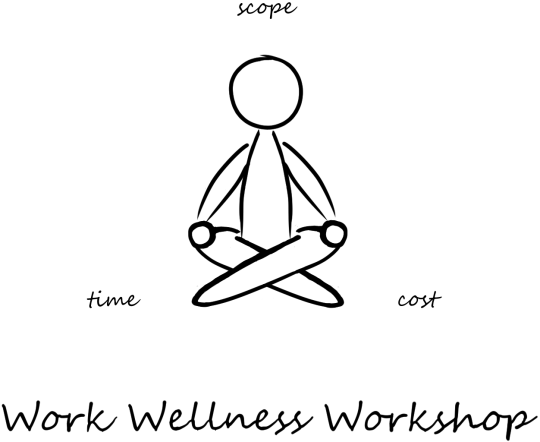
0 notes
Text
Quantum Scrum - a retrospective

(Photo: My team on the final day of the Ludum Dare 44 challenge. Note the lack of exhaustion and helplessness. :) Photo Credit: Museum of Digital Arts (MuDa)
From April 27-29, David Stark, Manuel Mumenthaler, and I set out to make a digital game from scratch for Ludum Dare 44. This sort of effort normally involves a mad dash, working inhumane hours to (hopefully) make a game. But we made a complete, artistically successful, enjoyable game while working manageable hours, staying on track, and working at our best.
We did it using my new invention: Quantum Scrum.
7 Sprints lasting approximately 4 hours each, with the complete cycle of sprint planning, “daily” check in, sprint review and sprint retrospective performed according to the Scrum Guide.
Quantum Scrum is my most recent downscaling of Scrum, designed to facilitate complex short term projects. The Ludum Dare challenge was the perfect opportunity to test it.
Traditional Scrum vs Quantum Scrum
In traditional applications of Scrum, projects can last years and a sprint lasts between 2-4 weeks, taking on complex interrelated tasks with the goal to have a complete, presentable increment of progress by the end of the sprint. Quantum Scrum does the same, except with a shorter project of smaller scope. In our case, we made a short strategy game in a few days rather than an epic RPG over years.


Functionally, Quantum Scrum is the same as traditional Scrum except for the Daily Scrum event. In traditional Scrum, the a daily event is required to make sure the team is working in accordance with the big picture, and coordinating its efforts in the best way. But a Quantum Scrum project is small and moves so quickly, there is no time for a 15 minute meeting between each significant effort. There is no need for such a long check-in either, as the scope of the project does not involve as many components, or as much time, and it is easier for the team members to know their place in the big picture.
Quantum Scrum is the minimum amount of interaction involved to uphold the Scrum framework and its incremental achievements.
Our experiment:
In Ludum Dare, a team has 72 hours to make a game based on a given theme. We agreed that for our team in Switzerland, these 72 hours would begin at 2:00 in the morning on Saturday April 27th and end at 2:00 on Tuesday April 30th. On Saturday morning, we would look at the theme individually, come together at 9:00, define our project and construct the most essential foundation of the game. On Sunday, we would get a working prototype and add the finishing touches on Monday. We would finish no later than 22:00.
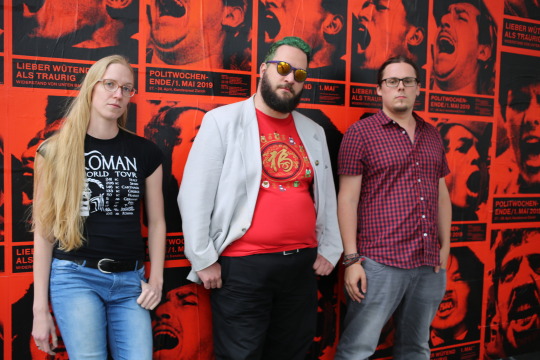
Manuel (right) would be the primary programmer, David (center) the artist and programmer as needed. I (left) would compose the music and sound effects and serve as Scrum Master.
We would work 8-9 hours per day, taking normal snack, lunch, and dinner breaks and sleeping normally also.
We would perform all the Scrum events, following the rules and roles of Scrum as written in the Scrum Guide, except for the role of Product Owner.
Our objective was to test the team’s dynamic, productivity, and the viability of Scrum on a small scale. There was no external demand for this project, no user stories to be considered, or clients to work with. As part of our team’s self organization, we would function together as the keepers of the product backlog. Our consensus would fill the role of Product Owner.
The project backlog would consist of post its on the wall. Every team member would have their own color of post-it. David = blue Manuel = pink, me = green.
A subordinate scrum board would contain post-its of the tasks needed for a particular sprint. This would serve as a check-in, fulfilling the daily scrum function. At any time, a team member could check off done work, to keep the scrum board current.
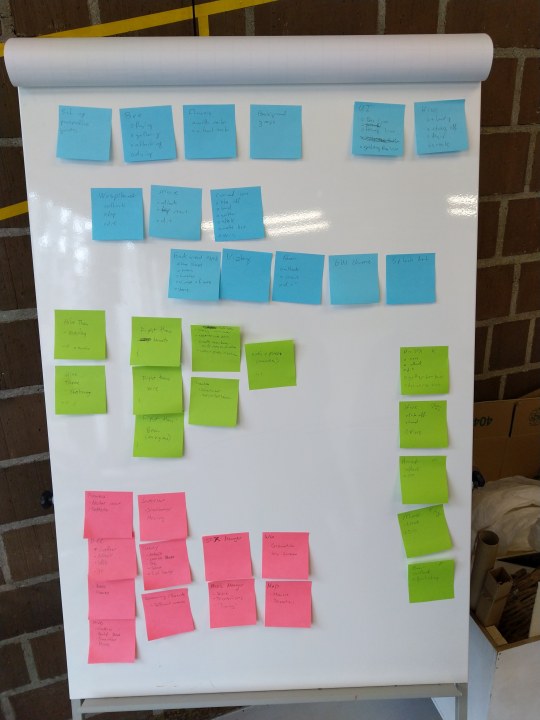
(Photo: the project backlog)
How We Did It
Before undertaking this challenge, David, Manuel and I met at a cafe. We established who was going to do what task, what tools were necessary to do it, and if there were any foreseeable obstructions to our progress.
Most importantly, we agreed that this project was not about developing our favorite personal ideas but making the best complete, playable game that a team can construct in three days.
This consensus was critical, and enabled us to create and communicate without fundamental obstructions.
Day I
The theme: Your Life is Currency
8:00 - Manuel and I had coffee before meeting with David. We brainstormed a bit, and Manuel had the idea that when a bee stings a large animal, the bee will die afterwards, so the bee’s life is like currency. This got us laughing about making a bee strategy game where if you got enough bees they could pick up the hive, move it, and take over a field.
9:00 - We arrived at the Museum of Digital Arts, where our workspace was, still laughing about bees. We sat down with David and started the official brainstorming.
David had carefully approached each word in the theme and came up with several ideas, including blood magician stockbrokers.
Of the proposed ideas, we narrowed it down to the strongest two: bees and blood magician stockbrokers.
Then I had to leave for a medical appointment that could not be avoided, leaving Manuel and David to investigate the mechanics of these two possibilities. The appointment kept me away until 12:00, but this caused no disruption because everyone was aware of it in advance, and there was enough work to be done that did not involve me.
12:30 - I returned. It turned out that both games were possible to make, but the blood magician broker idea needed narrative development, which meant additional work in roles we had not planned to fill, and the bee idea did not. So we chose the bees, then went to lunch.
During lunch, it was not allowed to discuss the game. We spent the hour chatting about other things, giving our minds a real break.
13:30 - We did a general project planning and created a project backlog, arranged left to right in order of priority. The priority and content of each item was agreed upon by consensus.

(Photo: David and Manuel with the project backlog)
Everyone’s role was well defined in advance. We each proposed tasks that we would perform along with details on how these would be accomplished. We often cross-checked with one another to see how singular tasks fit into the whole.
This project planning meeting took 90 minutes. It was not rushed. We took the time we needed to make sure the project on a large and small scale was as visible as possible. As a Scrum Master, I made sure that time was used efficiently and wisely.
We were all set to make a strategy game about bees, wherein you “control a swarm of bees. Gather nectar, care for your brood, defend against attackers. Gather enough nectar and you can bring forth the Imperatrix Apis, the Bee Empress.” - David
Sprint 1
15:00 - 19:00
To be done: foundational work

(Photo: Sprint 1 Scrum Board, which would function as the daily scrum)
Everyone worked separately. At 16:40 we did an informal check-in, saying what we did and what we plan to do next. Otherwise, a short question or glance at the scrum board was enough to keep us on track.
We had a sprint review followed by sprint retro, followed by planning for the next sprint, including getting the board ready.
While discussing, it became clear that we needed to record sound effects offsite, and it would be quicker and easier if we did it together. The best time to do it was that very evening.
So we got carry out pizza, went over to David’s flat, and recorded all of the sound effects. David and I designed them together.
I am the voice of the bee, Manuel is the Hornet, and David is the bear.
We made all of the sound effects with our mouths, except for the mouse, which is a combination of a sped up whale song and slowed down mouse squeak, which are essentially the same sound when the frequencies align…
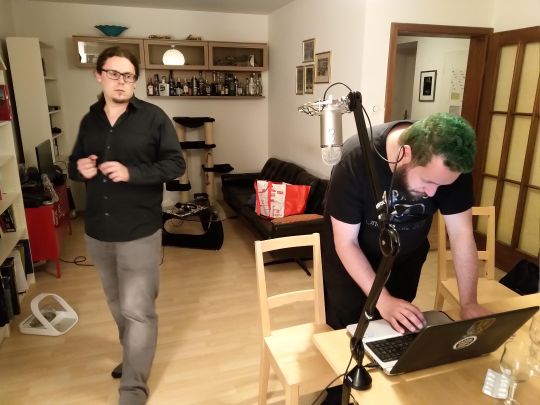
(Photo: setting up the mic for sound effects)
This recording session lasted until about 22:00. So we technically worked more than 9 hours, but since the recording session was a different sort of activity from the rest, it did not wear us out any more than if we had gone over to David’s to play a game.
At the end of Day I a third of our work-time was used up. Most of it had been spent on transparency and consensus. The slow, essential foundation of everything that could become our game.
Day II
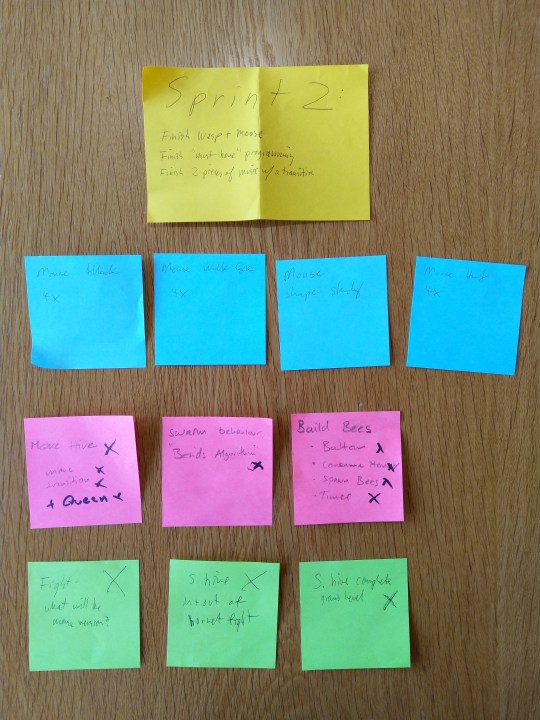
Sprint 2
9:00 - 13:00
To be done: Everyone had their own particular developmental goal.
D - Finish hornet and mouse drawings
M - Finish “must have” programming
K - Finish 2 pieces of music with a transition
9:00 - We got to work immediately.
David showed me how to use Git. That was unexpected and took about an hour out of our work time.
There was no real check in during this sprint though I did tell Manuel when I was done with the musical pieces he needed for his programming work.
At 13:00 we did a brief review and retrospective. We did the next sprint planning immediately and got the scrum board ready. Then we went to lunch.
During lunch, we did not discuss the game.
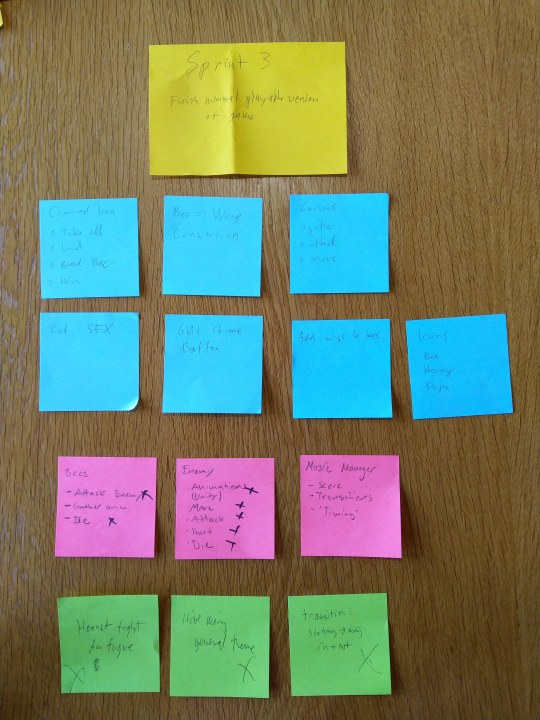
Sprint 3
14:00 - 18:00
To be done: Finish minimal playable version of game
David volunteered to mix and finalize the sound effects. He had more experience putting sound effects into games, and he had a clear idea of what had to be done, so letting him have the task was a logical choice. It also gave the sound effects an artistic unity that would have been lacking had we tried to finalize them together.
We all finished our planned work by 17:40, but did not reach the sprint goal. We did a sprint review, retro, and planning for one more mini sprint that day, as we discovered that there was only a small amount of work needed to meet that sprint goal. And everyone had the energy for that additional effort.
We had a long dinner. Went walking outside, got sushi and Starbucks. We chatted about non-game things and got to know one another better. The fact we were working on an intensive, time critical project was completely out of mind. As a Scrum Master, I made sure everyone could honestly rest.
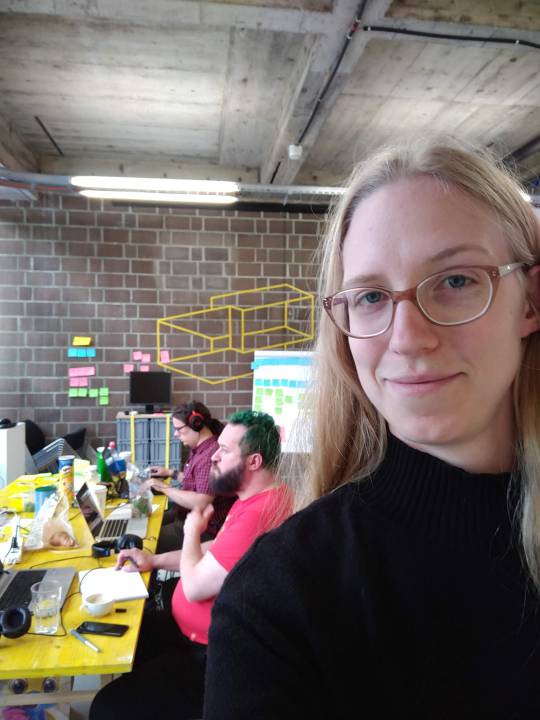
(Photo: me taking a break after finishing the hornet fight music.)
Sprint 4 (mini sprint)
20:00 - 21:00
To be done: Finish essential features
Done efficiently and without stress. We did this brief, focused sprint review and went home.
Manuel decided to finish up a small thing on the train on the way home, which is what seemed most comfortable for him.
At the end of Day II, we had finished an incredible amount of work and had the essentials of the game. But we did not a working prototype. And we only had 1 day left.
Day III
8:30 - I had coffee with Manuel. We ended up talking about the game, which was not a good thing. It showed a pending lack of balance.
9:00-10:00 Retrospective on Sprint 4. Planning for Sprint 5.
We re-prioritized the project backlog and got a clear picture of what the final day would entail. The bear got cut out as an enemy, because we knew we did not have time to develop it well. We preferred to make the hornet and mouse really good.
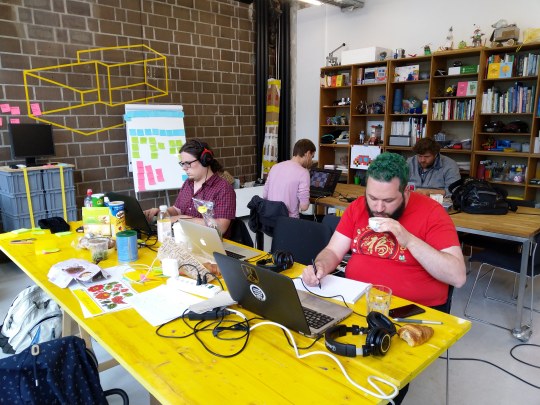
Sprint 5
10:00 - 18:00
To be done: Have a beta version that is playable.
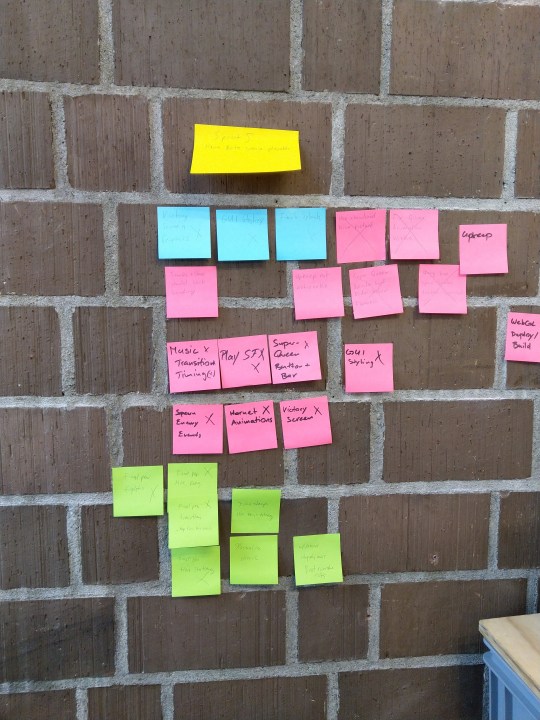
Rather than split this into two sprints, we kept it as one since the goal was the same. At this small of a scale, a full review, retrospective, and sprint planning would have interfered with the work being done. And since we were communicating well along the way, excessive catch-up was not needed.
So we thought.
The work proceeded fluidly. We communicated well as usual, but there was a quiet tension that increased throughout the sprint. Since we were in general a well balanced, cohesive team this did not impact our respect of one another, productivity, or intentional rest.
There were two breaks. The first was at 13:00 for lunch, after which we had a legitimate daily scrum. This seemed to resolve the tension and rejuvenate us.
We also took a second break to take publicity photos (because David had awesome sunglasses and we couldn’t resist the idea.)
We also did a brief check-in after this second break. We continued to be productive, but again, the quiet stress seeped into our sprint.
At 18:00 we finished the sprint. We met the sprint goal. It was a success. Except that we were starting to feel worn out.
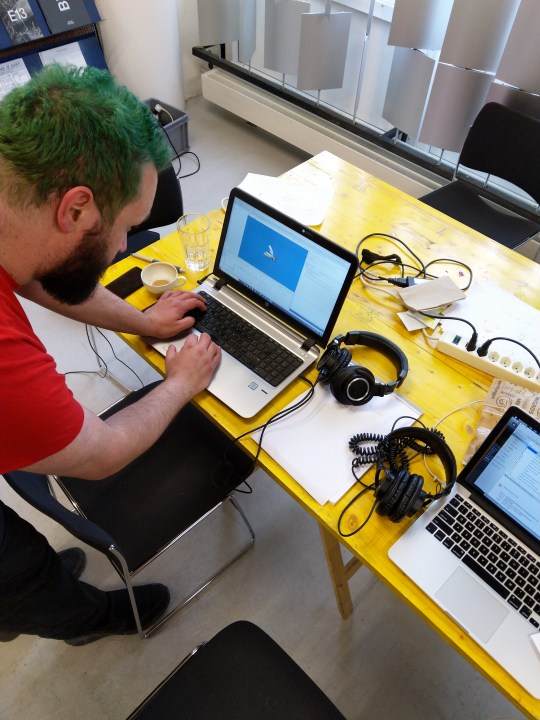
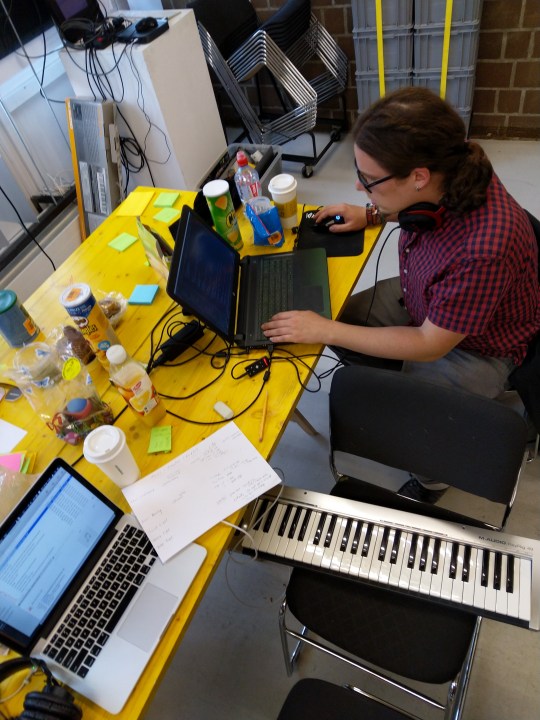
What was the problem? Here’s what I think: the duration of the sprint was stretched, thus the organizational framework was altered, and this needed compensation on the part of the team. The quiet stress resulted from the fact that we could not be certain when our work period would be over. Because we were unsure, the work started to drag. When work drags, it is noticeably stressful.
Good communication and flexibility disguised the importance of keeping the 4-5 hour framework. Sprint 5 should have been understood as two separate 4 hour sprints with the same goal rather than a single 8 hour sprint. That would have maintained the familiar rhythm of work and rest. When work gets hard, you depend on what is familiar, so have it be the right thing.
Also, no matter how wisely we had been working, we had truly been doing hard work for two days.
It was 18:00 and we had a working beta. Now we had to finish the game.
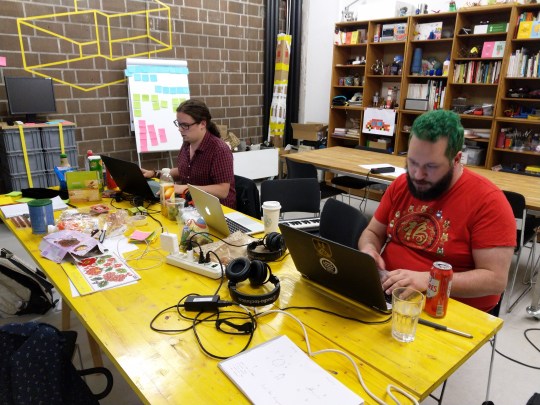
Sprint 6
18:00-20:00
To be done: Finishing touches
We worked effectively, but with additional effort. I started to take micro breaks to maintain mental sharpness. The fact that we were doing a lot of work in a short amount of time, plus the distortion of the framework on the previous sprint was catching up with us.
There was a small miscommunication between myself and Manuel. I did not understand how urgently he needed certain things, and thus did not prioritize them in a way favorable to him. That caused stress that could have been prevented.
There was also some question as to whether we should take a break for dinner. I did. The others did too, but with less determination. Dinner lasted only 30 minutes, and did not afford as much relaxation to the group as it could have. (The break was fine for me, but I am accustomed to this particular sort of work/rest discipline.)
Sprint 7 (Mini Sprint)
20:30-22:15
To be done: Finish the game!
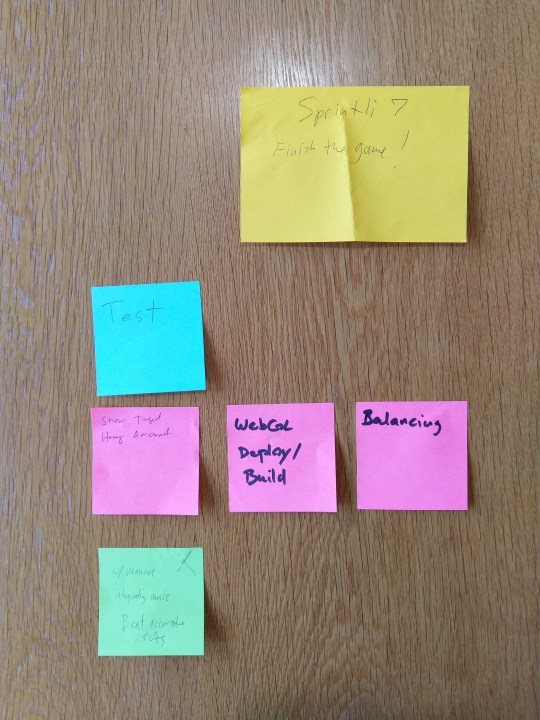
We did our final work. Manuel and David tested the game.
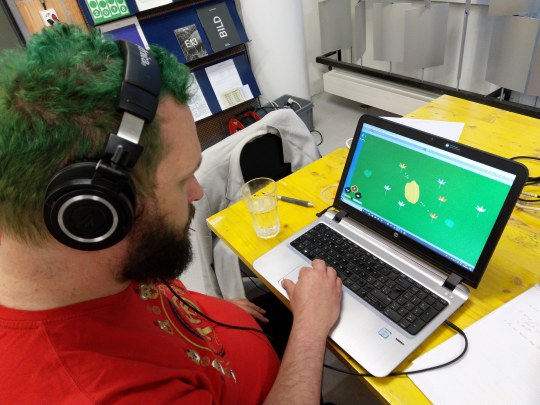
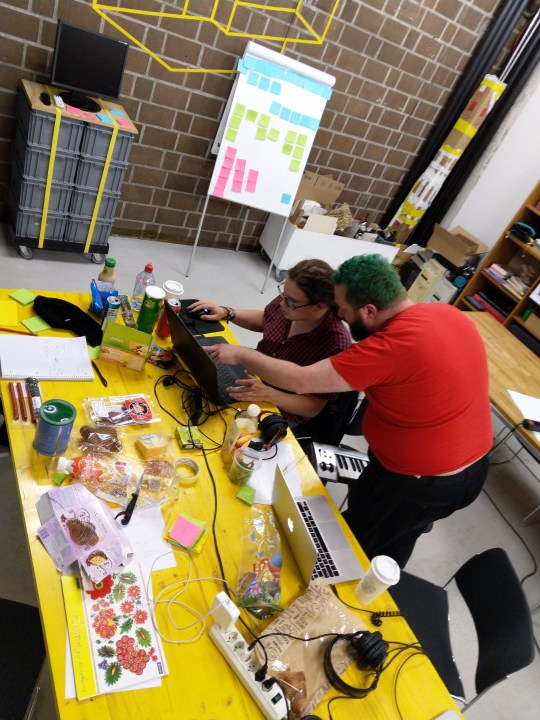
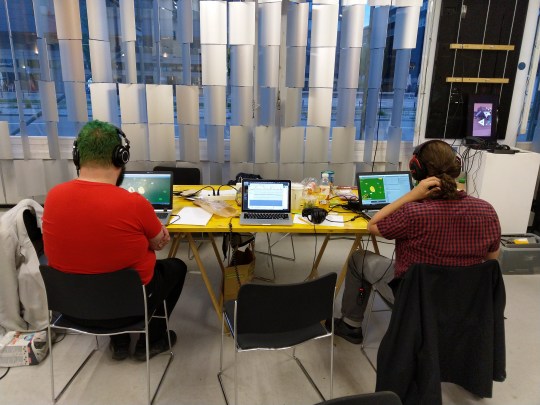
Our game worked, and it was artistically unified. We were done.
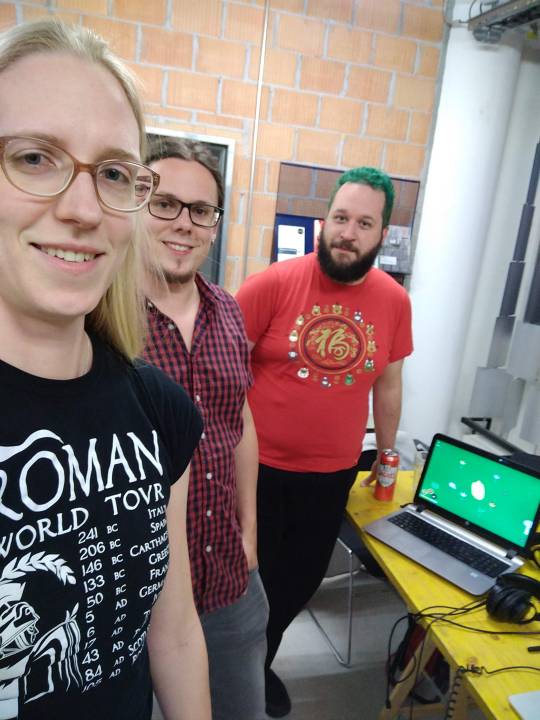
(Photo: The team. We are exhausted, but not anywhere near dead!)
The owner of the museum had left some beer for us. We celebrated and had a project retrospective.
Here is what we accomplished:
On Saturday morning, we looked at the theme individually, come together at 9am, defined our project and began to construct the fundamentals. On Sunday, we completed most of the work but not enough to get a working prototype. On Monday, had more work to do than we had planned. It was difficult but very manageable. We finished at 22:15 rather than 22:00.
Manuel was the programmer, David the artist and sound effects guy. I composed the music and served as Scrum Master.
We worked more than 8-9 hours per day, but we took normal snack, lunch, and dinner breaks. We also slept normally. Manuel said, “You had us take breaks before we knew we needed them,” which means that I did my job well.
We performed all the Scrum events, following the rules and roles of Scrum as they written in the Scrum Guide, except for Product Owner. The Scrum framework functioned as expected. Indeed, the daily scrum took a more fluid form, sometimes a glance at the scrum board or a question to a team member, sometimes an official account of what we did, what we were going to do, and what stood in our way from doing it.
We made a complete, artistically successful, enjoyable game in 3 days. It is called APIS. You can play it for free here.
And listen to the soundtrack I wrote for the game:
youtube
We proved that Quantum Scrum is an effective framework for completing short projects. It affords the transparency to see the challenges we really need to deal with, and the firm framework that allows for free movement and adaptability of the project's ideals within it.
Here is what we could have done better:
As a programmer, Manuel had the heaviest workload. He got stressed especially in Sprint 6 when trying to work the music into the game. That is where he and I had a miscommunication. In future projects, we could communicate better about stress levels and priorities. (In retrospect, I think the stress set in during the middle of day 2, when he pulled off an incredible amount of work, then decided to work on the train after the sprint. Ideally, the workload should have been distributed so that he would not have needed to do such a big push.)
In general, Sprint 5 should have been better defined as 2 sprints. I think this sense of security would have allowed the sprint to unfold better, and for sprint 6 and 7 to be less strained also.
We all agreed that having a single post-it board would have made the visualization process more efficient also.
Quantum Scrum worked
It REALLY worked. Quantum Scrum allowed us to finish a complex project in well focused increments within a very short time. And our team stayed healthy, communicated well, and slept normal hours.
Of course, we did a lot of careful work in the beginning, even before the challenge started. When the clock was ticking, we were aware of what we could do as individuals and as a team, and equally aware of the tools we had to do it. Because of this, our progress was efficient and focused.
Also, we took breaks at consistent times and respected the needs of our bodies.
David pointed out that this intensive Ludum Dare is designed for young, able bodied people without families. The reason that late 20s/early 30s people like ourselves were able to commit to these three solid days of work was because we have understanding partners and/or families, careful time budgeting, and preventative measures against stress injuries.
In addition to proving that Quantum Scrum is an effective way to organize complex short projects, our Ludum Dare adventure also showed that the best way to make progress is through cycles of work and rest instead of breakneck efforts. No matter your age, this is an important thing to understand.
As a Scrum Master, the biggest challenge was to maintain an environment that encouraged the appropriate free movements and discouraged obstruction. Because of the 3 day constraint on this project, the work being done was critical. There was no time to redo a task or venture off in the wrong direction and need to re-orient yourself. Each step had to be the right one for the final product.
0 notes
Text
APIS Original Soundtrack
I wrote a soundtrack.
youtube
The game it goes with is just as exciting. Play APIS for free, and vote for it, here:
https://ldjam.com/events/ludum-dare/44/apis
0 notes
Text
Quantum Scrum - an experiment in downscaling
How small can Scrum scale?
I showed previously here that Scrum can be used by individuals to develop creative projects. The product-producing machine that is Scrum functioned properly in spite of the fact only one person was operating it.
What if the machine itself was downscaled?
Scrum used for a team project, taking place over a very short period of time?
Quantum Scrum - the minimum amount of interaction involved to uphold the transparency, inspection and adaptation of the Scrum framework.
I’m going to try it.
The Experiment
In the Ludum Dare game development challenge, a team has 72 hours to make a game. Often, this means a 72 hour mad dash with a lot of caffeine and no sleep in an heroic effort to do more than you are really capable of. A team of three people: David Stark, Manuel Mumenthaler, and myself, intend to create our game working 8-9 hours per day, taking normal lunch and snack breaks and sleeping normally. And we will approach the project using Scrum.
We will perform all the events: sprint planning, daily scrum, sprint review and retrospective. We will follow the rules and roles of Scrum as they are written in the Scrum Guide, except for Product Owner.
A normal sprint can last one month. Our sprints will be 4-5 hours.
Our objective is to test the team’s dynamic, productivity, and the viability of Scrum on a small scale. There is no external demand for this project, no user stories to be considered, or clients to work with. As part of our team’s self organization, we function together as the keepers of the product backlog. Our consensus will fill the role of Product Owner.
Otherwise, our scrum roles are these: Manuel and David are developers. I am scrum master and developer.
Downscaling the Scrum Framework
In a scrum project, the project’s progress is perpetuated by finished increments created within sprints of a predetermined duration. The progress of each sprint is perpetuated by the daily scrum, which is a check in with the project’s goals: what the team completed the day before, what they mean to do today, and if there is anything preventing them from doing it.
Here is an example of a scrum project lasting 6 months:

And here is a Quantum Scrum project lasting 3 days:

The notable difference is in the daily scrum. For a project spanning months, a daily check-in with all the developers present and contributing is essential to keep everyone attuned to the larger scope of the project, as the details of daily work tend to consume everyone’s mind. But if the project is small, so is its scope, and it is not as difficult to envision or touch base with.
In Quantum Scrum the function of the daily scrum is served by individual efforts. There is a scrum board, which is continually updated by the team as work is completed. At any point, a team member can look at it, see the progress of the project and how their part fits into it. If they have a question or proposed change, they ask the other developers.
I am curious if this will be sufficient to function as the daily scrum, or if there will need to be a formal event during the sprint.
It is not possible to scale every aspect of the project, of course. Idea development takes its own time. There is only so much work and thinking that an individual can do in 4 hours, whether in a month-long sprint or a 4 hour effort.
Time will determine the project’s scope.
It will be interesting to see what it is possible to produce in 3 days, using 4-5 hour sprints and standard working hours.
0 notes
Text
Project Management Victory - How I wrote 20 minutes of a symphony in 2 weeks
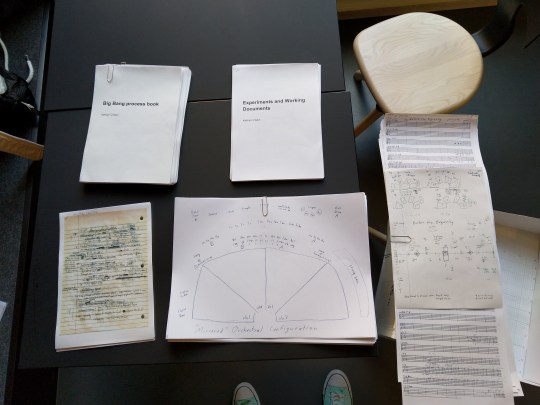
I applied to a music composition master’s program. The entry exam would require me to write or plan a composition based on a prompt, emailed approximately 2 weeks in advance of the interview. I did not know what this prompt would be, or what instrumentation I would be expected to write.
Here’s how I planned for the challenge:
I saturated myself with possibility.
I was diligent about daily practice of the fundamentals of music, to keep the known tonal possibilities alive and accessible.
I reviewed pieces already studied in depth. Whatever I was going to write in those two weeks would come from well-founded knowledge rather than recent inquiries. I read and listened to orchestral, chamber, and solo works by J.S. Bach, Wagner, Debussy, Beethoven, and Messiaen. As well as metal music like Nightwish, Xandria, Epica, Dark Moor, and Manowar. And the pagan/viking group Wardruna, which has remarkable rhythmic soundscapes.
While bathing in possibility, I did not stop myself from composing. There was a song series for the flute that just begged to be written, and I developed that in the week before the challenge.
I also cleared my schedule for the two weeks before interview and prepared to compress my work/rest cycles as much as they could be compressed. To perform 1 or 2 months worth of work in 2 weeks.
This sort of goal can be dangerous for your health. Had I not spent years developing project management skills and a rigorous artistic practice, I would not have been able to do it safely.
This was going to be a test of project management and self-knowledge as well as my ability to write a piece.
The interview was on April 18th. I received the prompt on the afternoon of March 27th.
I was supposed to plan or write a composition based on it and be prepared to show my creative process. The piece could be any instrumentation or any length.
The prompt provoked many ideas. The most gripping was a musical representation of the Big Bang.
I read the wikipedia article “Chronology of the Universe” along with some of its links. I felt like my head was about to explode. I saw the deepest human curiosities expressed in mathematics, wonder expressed through science. So many disciplines and subfields converging on the big question of how we came to be.
While walking down the street that evening, a massive orchestral piece came into my head depicting the phenomena I had just read about. I made written notes immediately.

I knew this was the piece I had to write.
But the concept was massive. And it was orchestral, with an alternative seating arrangement and non-traditional instruments.
How could I do it in 2 weeks?
The 27th was a Wednesday.
On the 28th, I read as much about the Big Bang as possible, and rested.
On Friday the 29th, I rested some more, then assessed the boundaries of the project.
Let time determine scope.
The project’s tasks consisted of the following:
Idea mapping - getting the piece from my head to paper so I had something concrete to analyze and build upon.
Input - Read science and math connected with the Big Bang, so far as I can understand it. Get expert opinions on theories if there is time.
Improvisations/inventions- playing with my musical ideas to find the best way to represent the phenomena I would like to portray.
Notation - writing down as much of the finished idea as possible, accurate to the beat and pitch. (For me, this takes a lot of time.)
Materials to present - collect all the work documents and scores, copy them, and present to the committee in a way that makes sense.
Here’s how I planned to approach these tasks, working no more than 8 hours per day:
Prep-weekend - primary Ideation and input
Fri evening (29.03.2019)
1 weekend day
1 weekend night
Week 1
Mon night
Tue, minus evening. - Improvisation/idea development
Wed
Thurs, minus evening.
Fri, minus afternoon. Plus evening.
1 weekend day - Begin notation
1 weekend night.
Week 2 - Notation
Mon night
Tue, minus evening.
Wed all day
Thurs, minus evening.
Fri, minus afternoon. Plus evening.
1 weekend day
1 weekend night.
Presentation Week - finish up
Mon night
Tue
Wed
The estimated time allotment is based on personal performance metrics.
Work/rest cycles:
When I do work, it is very intent and focused, and it has a cost. Just like in physical sports, mental exertions must be balanced with rest.
Ordinarily, I devote 2-4 hours per day specifically to composition, and this only 4 days per week. The rest of my musical time is devoted to instrumental and vocal practice, listening, and living mindfully. This is my natural work-rest cycle for composition.
In these two weeks, I would need to also work on Monday nights, plus one day and one night on the weekends.
That was going to demand a lot of energy and focus.
I would need to work at a higher frequency of work and rest, respecting the completeness of both. And only develop ideas that really fit the project.
Each task has its own lifecycle. The trick to accomplishing multiple tasks is by seeing them as part of one whole project and jumping from one to task to another at the proper time to make an effective change.
If a task is well conceived, and fits into the whole project, then the project can develop naturally and holistically.
There is a limit to the number of cycles to which a person can constructively contribute.
I simplified this project into three: input, development, and rest.
Each day involved all of them: input by researching the Big Bang and listening to music, development by refining musical ideas and making mindful decisions about which ideas to pursue and which not. Then I would rest by sleeping, meditating, or having a chai latte at Starbucks. In this way, I could accomplish 2 or 3 days worth of work in 1.
As to the output for these cycles, I was flexible. I had to deliver a well-defined concept, as much finished music as possible, and materials which showed my process. The content of these deliverables was would be however much of the symphony as I could finish in 2 weeks.
I would keep my working documents clean, so they could be presentable without further alteration. I would also keep a daily diary of my work, which would become an accurate process book without much revision.
This daily diary would also give empirical data from which I could plan my next moves.
I would, above all, obey my rule of not pushing and only working with proper rest and concentration.
Here is what happened:
Primary Ideation and input:
Fri evening (29.03.2019)
Slept ok. Meditated.
Enrich understanding of the prompt and the project. Make the master conceptual sheet. Established approach to the project. Established approach to tonality.
1 weekend day (30.03.2019)
Slept ok. Woke up with the opening of the symphony playing in my head. Meditated.
Sketched musical ideas for early universe and Dark Ages. Investigate rhythm. Realized it would be faster to notate by hand because Musescore could not readily account for all the time signatures I needed.
Rested in the evening.
1 weekend night (31.03.2019)
Slept ok. Meditated. Rested during the day.
Further analysis of rhythms. Simplifications and groupings. Established approach to rhythm.
Week 1
Mon night - (01.04.2019) Injured my left knee, so meditation had to be altered. Rested all day and night. No joke.
Improvisation/idea development
Tue, minus evening. (02.04.2019)
Slept ok. Alternative meditations were not as effective as my core practices, but it was the best I could do.
Translated astrophysics into musical ideas. Text definitions, and inventions on the piano. About 11 minutes worth of music. Started master rhythm scroll, comparing the multiples of selected time signatures. Went to Starbucks in the afternoon to recuperate. Had a meeting for another project that evening.
Wed (03.04.2019)
Slept poorly during the night. Meditated, took a nap in the morning, until 12:00. Meditated again, then investigated coincidence of multiples. Wrote first detailed draft of the first movement, Before the Beginning.
Thurs, minus evening. (04.04.2019)
Slept ok during the night, but not great. Meditated, still felt tired. Idea for form developing out of swirling gasses - featuring 3 flutes. Took a nap. Then experiments with 4/4 and 5/4 relations and rhythmic statements for percussion. 4 minutes worth of music. Rested during the evening while at a meeting for another cause.
Fri, minus afternoon. Plus evening. (05.04.2019)
Slept poorly. Felt very exhausted. 2nd draft of Before the Beginning. Rested and meditated the remainder of the day.
1 weekend day - (06.04.2019)
Slept poorly. Meditated. Took a nap.
Begin notation? That didn’t happen, because the overall sense of scale was not established. Instead I got feedback from a mathematician on my coincidence of multiples and investigating that further to find the master rhythms. Established the specific rules of rhythm, thus a chronological framework consistent throughout the piece.
Rested during the evening.
1 weekend night. - (07.04.2019)
Rested all day, except a written plan on how to finish up development and deliver.
Week 2
Mon night (08.04.2019) - Rested. Meditated. Took my daughter to see a parade.
Tue, minus evening. (09.04.2019)
Knee is feeling better. Slept ok. Meditated more like usual, and it was more effective.
Investigated smaller coincidences on the master rhythm chart, and established how to represent the 4 fundamental forces musically.
Wed all day (10.04.2019)
Slept ok but not enough hours. Meditated.
Read theories of the very early universe. Detailed drafts of second movement: Planck epoch, Grand Unification, Inflationary epoch, Quark epoch, Hadron epoch. General drafts of Neutrino decoupling/Lepton epoch, Big Bang nucleosynthesis, Photon epoch. Made voicing experiments and tested thematic developments in MIDI. 5 minutes worth of music.
Thurs, minus evening. (11.04.2019)
Slept ok but not enough hours. Meditated. Napped in the morning. Rested all day, except to record a second draft of Before the Beginning (first movement.) I had the first and part of the second movement finished. It was time to notate.
Fri, minus afternoon. Plus evening. (12.04.2019)
Slept poorly. Meditated. Rested the whole morning.
Prepared notation paper. Took about 5 hours and was very stressful. (Here’s where it really started to get difficult. I started to take more frequent micro-breaks.)
1 weekend day (13.04.2019)
Slept ok, but not enough hours. Meditated.
Ideally, I would have rested the whole day, but I needed to notate. So I notated a few hours in the morning, took a nap, and notated again in the afternoon and evening. I notated Before the Beginning in full score. 4 minutes worth of symphonic music.
1 weekend night. (14.04.2019)
Slept poorly. Meditated. Would have rested the whole day, but I needed to notate.
I worked all day, in three parts with two naps separating each one. I notated, in miniature score, as much of the second movement as possible. Grand Unification and some of the Inflationary Epoch. About 6 minutes worth of symphonic music.
Finish up:
Mon night (15.04.2019)
Slept ok but not enough hours. Meditated and rested, except to export audio files from computer.
Tue (16.04.2019)
Slept ok, but not enough hours. Meditated.
Scanned and printed materials. Practiced presentation.
Wed (17.04.2019)
Slept ok, but not enough hours. Meditated.
Scanned and printed materials. Practiced presentation.
Meditated.
Thurs (18.04.2019)
Slept ok, but not enough hours. Practiced presentation. Meditated. Took a long train ride to the interview, while meditating. Showed up, meditated some more, and did the interview while in meditation.
They did not accept me into the program, but it was for a good reason. If I am self-directed, artistically developed, and organized enough to do this sort of work in only two weeks, why should I spend 2 years primarily focused on developing the ability to be self-directed, artistically developed, and organized?
(Photo of my symphonic workspace with first movement in full score.)
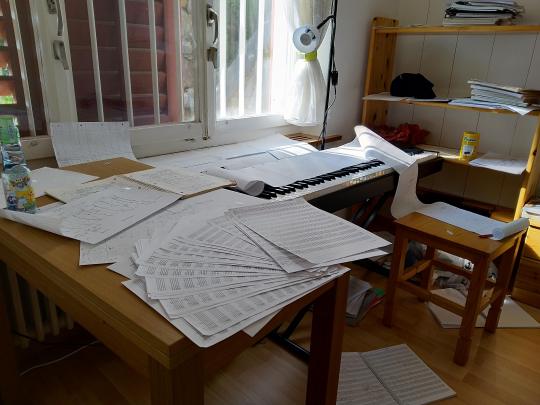
(Photo of the finished full and miniature scores.)

I developed 10 minutes of a symphony precise to pitch and tick, an additional 10 minutes in detailed sketches, 20 minutes of inventions and experiments, delivered a process book and a concept as large as the cosmos in only 2 weeks.
I worked no more than 8 hours per day, rested one whole day per week. Was able to go to meetings for other projects, take my daughter to a parade, and have chai lattes at Starbucks.
It really helped that this project burned in my mind the entire time and it was largely a matter of managing the outflow of ideas so that I did not exhaust myself.
For me, the art making process is always like this. There are lightning bolts and violent raptures. Good project management makes it possible to create these massive projects safely and mindfully.
0 notes
Text
Symphonic Project Teaser

It involves spiraling passion, mathematics, and the Big Bang. Can't wait to put these notes down...
0 notes
Text
The Chromatic Scale from 6 Perspectives

All of the following concerns equal temperament.
In tonal music theory, much attention is given to the octave as a structural constant. The octave divides the unending succession of chromatic pitches into manageable chunks. It is the container for scales; the point at which the harmonic interaction of intervals begins anew. The strength of the octave differentiates one key and mode from another. But it is not the only structural constant in western tonality.
There are symmetrical intervals, which proceed in unbroken threads through the tonality regardless of register, scale or mode.
There are six types of symmetrical intervals that I am aware of: the semitone, whole tone, diminished seventh chord, tritone, augmented triad and of course the octave.
The semitone: The smallest (conventional) interval in western tonality. The chromatic scale is made up of these, strung together from the lowest to very highest notes. There are 12 semitones in an octave.
The whole tone: An interval two semitones apart. There are six of these in an octave, and are known as the whole tone scale.
The Dim7 chord: The most ‘compressed’ of the seventh chords, made up entirely of minor thirds. After four intervals, the octave is reached and the pattern is considered to start over.
The tritone: Often thought to be the least stable interval. An augmented 4th or diminished 5th which demands to resolve up or down the scale.
The augmented triad: Another stepping stone chord, and frankly I’m still fishing around for its official purpose.
These definitions are all based on the symmetrical interval’s interaction with the octave, which is a great way to keep tonal concepts from being lost in a seeming void. However, an octave is only one way of dividing tonality into manageable chunks, and it is not always the most structurally accurate.
Look at the symmetrical intervals from the perspective of the chromatic scale.
The chromatic scale is the foundation of western tonality. Every tone and interval has a fixed position. Unlike major or minor scales, tones cannot be removed or added to it to give the chromatic scale a different color or mood. Is it because of this immutability that tonal compositions often avoid the chromatic scale except to move from chord to chord?
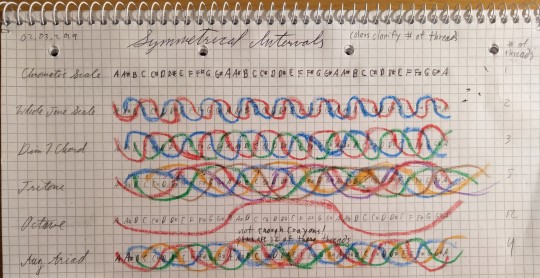
The semitone: the chromatic scale at the smallest level.
The whole tone: Zoom out a little. The whole tone scale is the chromatic scale observed in groupings of two semitones. Or skipping every other semitone. To use all the notes in the chromatic scale, you need two threads of whole tones, involving for example the whole tones associated with A, and the other thread involving the whole tones associated with A#.
Dim7: Consider the chromatic scale in terms of minor thirds. The Dim7 chord would be a collection of four consecutive intervals, but this is an arbitrary grouping. The Dim7 relation continues through the full range of pitches. To account for every semitone, there are three such threads of minor thirds running through the tonality.
Tritone: Zoom out a little more and the tritone is the next symmetrical interval. The tritone a minor third x2. To account for every semitone, there are five such threads of minor thirds running through the tonality.
Aug triad: Consider the chromatic scale in major thirds. There are three such threads of major thirds running through the tonality.
Octave: Zoom out a lot. Every pitch in the chromatic scale has an octave. There are twelve of these threads running through the tonality.
Take any singular pitch in the chromatic scale, and all of these symmetric intervals proceed and follow it in some form.
In equal temperament, the symmetrical intervals are unalterable, I believe, for the same reason the chromatic scale is unalterable. They are the constants of the entire tonality.
Furthermore, the symmetrical intervals are actually the chromatic scale, just perceived in different groupings.
0 notes
Video
youtube
Here is a talk I gave at Liip AG in Zürich about how I use the Scrum framework to write epic fantasy novels. To the best of my knowledge, this particular scaling of the Scrum framework has not been used by anyone else. (If it has, I would like to know, and compare notes with them.)
Enjoy!
0 notes
Text
Managing projects well
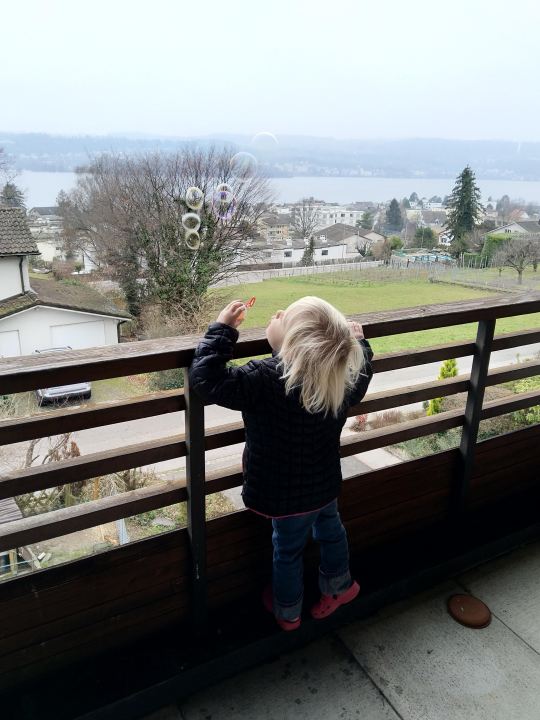
No matter what scale I’m working on, there are a few essential principles that help me to organize projects effectively:
Don’t control, facilitate
As a project manager, my job is to create a well-defined space in which people can do their work. Trust that they know what they are doing, and help them to do it.
Ask for feedback
Just because I think a suggestion might helpful or appropriate doesn’t mean that it actually is. Since I mean to be as effective as possible, I would like to know immediately if I am missing the mark. There is no shame in asking your team for feedback, and encouraging a culture of honesty. In fact, it is one of the best things you can do to connect with your team and encourage your team to connect with one another.
Understand your framework(s) and diagnostic tools for troubleshooting
As a project manager, it is my responsibility to understand the frameworks I am using, the state of the projects within them, and the movement of the projects’ moving parts. And I need tools to diagnose why things aren’t working.
These tools are developed over time, through experience. Reading books and case studies can help with understanding, but the most effective tools are developed through experience.
Keeping charts and notebooks is a great way to keep track of this understanding of frameworks and tools. If the project manager does not understand the entire project on a large scale, how can they guide it effectively?
Conduct experiments
Project managers can be innovators too. In order to make the best informed decisions and perceive upcoming challenges, we must have a broad, experiential understanding of the problems and solutions. What better way to do this than to seek empirical information in a controlled environment?
If I don’t feel comfortable conducting an experiment during a project, it is a sign that I don’t understand the project and/or frameworks well enough.
Know your team(s) as people, not just as moving parts of a system
All of these frameworks, charts, predictions, and experiments really have no purpose unless they serve the teams working on the projects. And the teams are comprised of real rather than theoretical people. Know them, and you get critical empirical data about what is really there and what is really possible.
Ultimately, the project manager is a servant to the team, and the liaison between product vision and product reality.
0 notes
Text
Why be self-taught?

With so many wonderful, comprehensive programs available nowadays, why go through the pain of teaching yourself something? I have often thought about this, especially while in my study trying to understand programming languages for the umteenth time, wishing I could just progress through a class rather than mess around with all of this myself.
When one is self taught, there are no safety nets. There is no one to tell you that you are missing a critical concept, or that a task might be better approached from a different direction. There is no pre-defined route to guide you through a daunting web of knowledge. There is only you, your wits, and the terrain beneath your feet.
Sound adventurous? It is.
Every piece of knowledge gained is rightfully yours, acquired through experience and critical reflection. It is like walking 20 miles instead of driving it. You know the character of the land, the mud on your boots, the strain on your legs, and the hunger that drives you to the destination. And when you get there, you truly appreciate it.
Self-teaching is an adventure, which requires you to know and respect yourself, to have the courage to be honest about your capabilities, open to make changes, to focus and commit to achieving your goals.
0 notes
Text
Inversions of chords
When I learned inversions in theory classes, they were a thing to be memorized and applied to chord changes based strong or weak functions and accessibility on the piano. They existed as fragments in a void. I never understood them operationally (and, I admit, did poorly on the homework.)
Recently, after exploring electron models on the piano using one degree of the triad as an anchor (see previous post), I tried playing different scale degrees in both hands, and it occurred to me that a chord has dimension not only up the scale but also down. Positive and negative. Seems obvious, doesn’t it?
So, treating the anchor like zero, I explored the intervals progressively on either side of it. What I discovered was awesome.
(Demonstrated in C major.)

The inversion no longer existed as a fragment in a vacuum, but was a complete form. The theory books were only showing one half of what an inversion actually is. No wonder I had trouble understanding it.
0 notes
Text
“Electron” models of chords
One thing that has always irked me about chords in music education materials, is that they always seem to be introduced like this:

Scale degrees with interval names, static chords on a staff.
Then nothing more is said about their structure.
But in order to compose music you need to understand the behavior of chords from uncountable trajectories (or can they be counted….?) Chords are dynamic, moving things. I set out to model them as such.
Using the C major triad, I started playing the degrees randomly all over the piano at a quick tempo. What I heard was too confusing to sort out (too abstract to understand structurally), so I limited the left hand to one note, let’s call it an anchor, and played other degrees with the right hand.
What I discovered was the aural shape of the C major triad from multiple directions. It was as if I owned a car which I kept in a dark garage. I had never seen it, only touched it, then someone turned on the overhead light and finally I could perceive its larger form.
The possibilities of the C major triad, for chord progression and an outline of the key of C major’s mood was suddenly clear to me.
Here is an example of a C major electron model for the C triad’s root position, 1st, and 2nd inversions:
youtube
And a broader one, exemplifying the C triad’s root position (C is the anchor note):
youtube
I call it an electron model because the notes quickly appear and disappear within the chordal “atom” as electrons are purported to do in real atoms according to quantum theory. (At least this is what my scientist friends tell me.)
0 notes
Text
Kathryn Criston - Musician and Composer
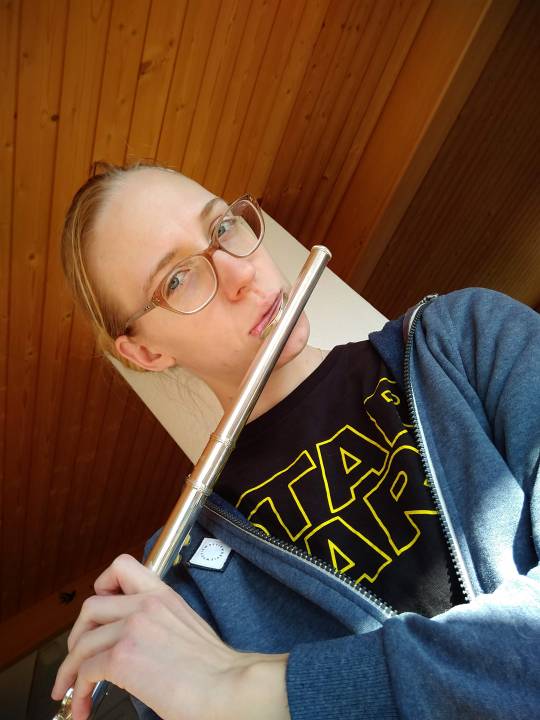
This is a sort of ‘coming out’ for me. At the root of all my organizational and artistic inquiries lies a firm foundation of music, and it is personal. My father was an audio engineer who studied jazz piano, and there are professional musicians on both sides of my family. I grew up as a music kid, playing piano, cello, violin, and a bit of flute. I played cello primarily, participated in youth orchestras and other special programs. I left high school with the foundation for a career in music. But there was one small problem. I couldn’t read notes.
There was a disconnection between the little black dots and their meaning, and no manner of practicing would fix it. Everything I played with the youth orchestras and as a soloist was done by ear, and by form. I had to know very well how a piece was functionally structured, in order to perform it at all.
As such, I gained a valuable understanding of how musical pieces, big and small, were constructed, and what functionally constituted a composer’s style. I studied a bit of music theory, or tried to, but found it as abstract and immobile as algebra. At this point in my life, I was afraid of math, and the thought of inquiring into music theory did not occur to me.
So what could I do? I was a musical misfit.
In college, I did not pursue the cello, but turned to filmmaking, photography and other arts. But I could not completely cut myself off from music.
I took up classical singing, in alignment with David Jones and the Swedish-Italian school. The art of vocal production fascinated me, along with the music performed by choirs and soloists, especially sacred repertoire. I became a choral singer and budding soloist, flirting with opera but not pursuing it, as the lifestyle and roles I would be required to play did not seem fulfilling.
As with the instrumentalist’s life, the singer’s inquiry into music was largely, “Understand your part and how it fits into the others, develop your interpretation of the role, perform it, and move on.”
I had to be honest with myself about what I needed as a musical person. Being an instrumentalist was not enough for me. I wanted to ask questions of music itself, to tinker with it, know it, and express ideas with what I discovered. I also had an instinct to organize multiple moving lines into a larger piece dependent on the interplay of these moving parts. That made me a composer.
Uh-oh.
To a strict instrumentalist, composers are mysterious, unpredictable beings who pull completed works out of thin air. For awhile, I feared to call myself a composer, especially because my education was incomplete. But I found myself going to musical events, introducing myself as a singer or instrumentalist, getting distasteful looks when I explained that I played cello, then sang, and now play the flute, but I am really not an inconsistent person at all. Then I’d go on to talk about the structure of music and looks of distaste would become horror or confusion.
When I started introducing myself as a a person studying to be a composer, the social perception changed. A composer who spent years in an orchestra, in choirs, and now a wind instrument knows an orchestra more thoroughly than one who has only played a single instrument, or really only plays piano and understands the orchestra only in theory. It is acceptable for a composer to ask strange questions, or reply with strange answers. It is also acceptable for a composer to play an instrument poorly if they are using it to illustrate an idea.
Now I can say with confidence that I am pursuing composition. This requires a thorough, operational understanding of music theory.
So I am tinkering.
I am developing models of the theoretical structures in music. Some are two dimensional, others three. I would love to include more dimensions if given the opportunity.
Some of the models are visual, others auditory. All are meant to facilitate not only an understanding, but functional ability which I can use to develop music.
This is an ongoing project which I hope, after a few years, will result in my being fluent in music theory and able to express musical ideas on any scale, with liberty.
As to my inability to read notes, I think it actually enables me to better understand how music fits together. Because if I don’t know, I can’t play. And there’s nothing like necessity to provoke true invention.
0 notes
Text
On my use of terms like “Perfect 11th”
I have not encountered a perfect 11th or 12th in formal music theory, but I use the terms here because the a perfect 11th is a perfect 4th with an additional octave of space between the degrees, as a perfect 12th is a perfect 5th. I consider the octave to be a unit of measure, a repeating set, that affects scale but not the notes of an interval or chord. So for example in a C major triad the notes C E and G could be played anywhere on the piano and it would still be a C major chord.
The relationships between the degrees are structurally the same. The inversion is structurally the same.
Another example, take the C major chord in an orchestra piece, the cellos could play C2 contra, the violas E2, and the violins G3. It is still a C major chord in root position, as if you would play C3 E3 G3 on the piano with one hand.
It is the same with the chord’s inversions also.
I am not suggesting that these chords sound the same. The physical distance between notes affects the emotional tone of a piece significantly. I am only speaking of the chord structurally, as being made up of C, E, and G.
0 notes
Text
How triads connect in chord progressions
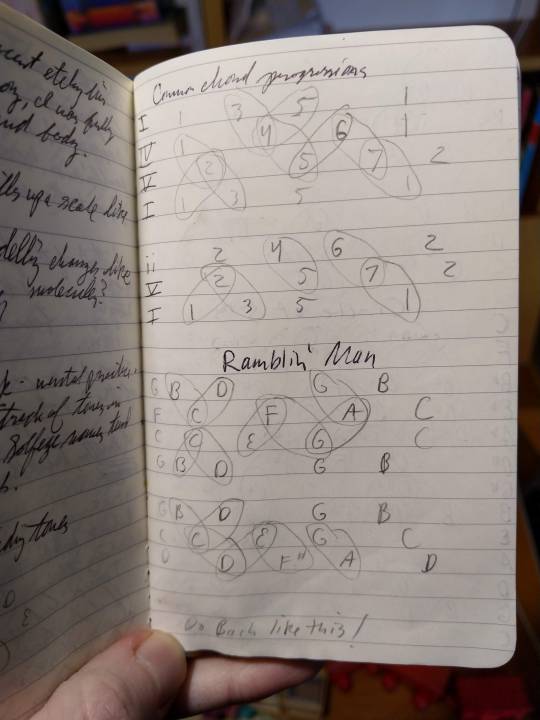
While playing around with chord changes, I wanted to understand how many options there were for moving from one triad to another.
These models show how, in a chord progression, a triad’s degrees, when resolved up or down, arrive at a triad’s degree in the next chord. The movements are modeled within one octave only because my notebook is small.
Here are the common progressions I-IV-V-I and ii-V-I.
And I decided to look at the chord changes in The Allman Brother’s tune “Ramblin’ Man,” continued in the photo below.
And I could not resist exploring the Circle of 5ths, which makes for a nice chain-link fence.

How useful are these models? No idea. Can you think of any applications for them?
0 notes
Text
Introduction

I am a synergetic thinker, an experientialist, an innovator and artist, and every bit as evil as I look in this picture. But if one is going to be evil, one must do it responsibly, and use one’s wicked insights to do good.
Here you will find writing about project management, scrum, unconventional uses of frameworks and visualizations, and explorations of music theory concepts.
I think of musical pieces as multidimensional geometric structures which transfigure over time. My models are meant to exemplify the individual forms which make up these complex, dynamic structures.
Please leave comments as you see fit. I welcome any feedback as long as it is well considered.
Thank you for visiting,
Kathy
0 notes